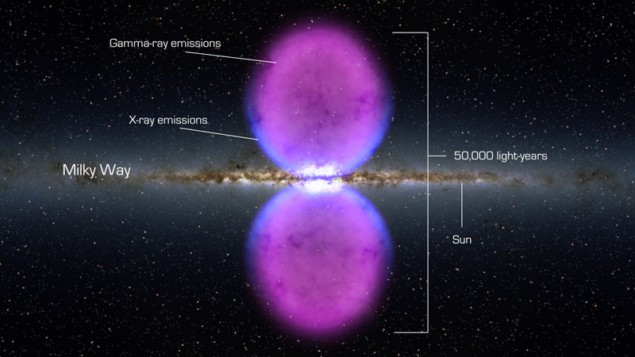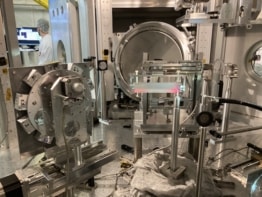
Giant bubbles of gamma-ray-emitting materials surrounding the Milky Way are created by our galaxy’s central black hole – and its appetite for stars – according to an international team of astronomers.
Back in November 2010 astronomers using the Fermi Gamma-ray Space Telescope released details of a colossal but previously unseen structure burgeoning out from the core of the Milky Way (see figure). Stretching some 25,000 light-years above and below our galaxy’s main disc, the well-defined edge of these two gamma-ray-emitting “bubbles” hints at a sizeable and rapid release of energy as their creator.
Some astronomers have suggested that our galaxy’s central super-massive black hole is powering the mysterious bubbles, but the exact process remains unclear. Now, a team of researchers led by K S Cheng at the University of Hong Kong has created a model that makes the connection.
Capturing stars
“I’d been working with Vladimir Dogiel, based at the P N Lebedev Institute of Physics in Moscow, on the link between the unusually high-energy phenomena at the galactic centre and star capture by the central black hole,” Cheng told physicsworld.com. “When we saw the discovery of the bubbles last year we realized it too was a phenomenon that could be included in our model,” he added.
The black hole at the centre of the Milky Way is a behemoth with a mass four million times that of the Sun. It has long been known to consume anything that ventures too close, and Cheng’s model suggests it chews up stars at a rate of 100 every 3 million years. Astronomers believe that only 50% of the mass of the dilapidated star gets swallowed by the black hole; the other half gets “burped” back out into space before it reaches the point of no return.
This regurgitation blasts very hot plasma – with energies of around 10 keV, according to Cheng – out into the surrounding galactic halo, raising the ambient temperature. Having been heated, the halo then expands. Cheng’s model describes how, as the black hole continues to devour stars, shockwaves are created as hot plasma is repeatedly and periodically injected into the halo. “We used the analogy of the Sun ejecting the solar wind into the solar system,” says Cheng. “When the solar wind blows out plasma it too causes a bubble: the heliosphere,” he explains.
Particle accelerators
Each shockwave acts as a particle accelerator, increasing the speed of electrons within the plasma to near that of light. Indeed, Cheng expects that the energy of the shock front at the galactic centre is nearly 100 times greater than that created by a supernova explosion. These speedy electrons interact with photons in the galactic halo, boosting some of them up to the gamma-ray energies observed in the bubbles.
However, Cheng and colleagues are not the only scientists with a theory. Stefanie Komossa, an astrophysicist at the Max Planck Institute for Extra-Terrestrial Physics, Germany, told physicsworld.com: “More continuous accretion onto the black hole from interstellar matter or molecular clouds, like we see ongoing in other active galaxies, could be responsible too.” But she does recognize strength in Cheng’s argument. “The disrupting of stars by the central black hole is still a very plausible explanation as we know that these events are unavoidable,” she added.
Confirmation of Cheng’s theory could be around the corner. “We’re currently running our next simulation and then we expect to have a theoretical map of the distribution of gamma rays in the galactic halo. Our map can then be compared to those constructed through telescope observations,” Cheng explains. “The work is ongoing but we expect to have some results in the next six to nine months,” he adds.
Cheng’s model is described in a paper submitted to Astrophysical Journal Letters and a preprint is available on the arXiv preprint server.



